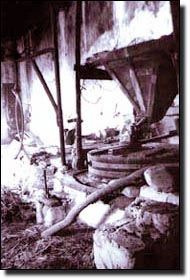 |
 The Mills Path The Mills Path
Following the municipal route, from Marineo to Risalaimi, at the bottom of the valley, you can see the “Eleuterio Mills”. In the middle of a luxuriant vegetation, full of colours and scents, in splendid blends (what a story everywhere!), it is possible to go on excursion following the historical architectural traces left by men, century by century.
The oldest pieces of information about these mills date back to 937, at the time of Arabian colonisation. Still working till some decades ago, they are today in ruins and no more used as mills. They keep nevertheless the ancient charm of peasants'culture.
The WATERMILL is one of the few examples of industrial archaeology in our territory. Its capacity depended on its width, and on the flow and the deepness of the river. The presence of little streams, whose slope is steep and whose flow is discontinuous, has caused the spread of a particular kind of mill, THE SICILIAN MILL, present all over the island. The mills were used to produce wheat meal, to full clothes, shell cotton, press sumach and sugar cane (once a very important resource of Sicilian economy - XV and XVI centuries) and at last to produce olive oil, since the Arabian conquest.
Going along the municipal route, from Marineo to Risalaimi, reaching then the valley bottom, in direction of Misilmeri, for some hundreds of metres, you can see Risalaimi Houses, on the other bank of the river. It’s one of the most important centres of this area, founded in XIII century near the water source of Risalaimi. The Norman kings gave the land to the Cistercian monks and then it became one of the Teutonic Knights’ estates. Situated in a crossing point, between the hinterland and the coastline, it was a place of production of oil and flour, but also a resting point for travellers and traders. All this took to this area a strong political and religious power.
In XV century, T. de Vigilia and his helpers frescoed the walls of the chapel near the farm. At the end of XV century, many fortresses and defensive buildings were built, under request of the noble family Ram, whose coat of arms still stands on the main door of the farm. All these buildings were intended to defend the site and the source. The only thing remained is the main tower, a little bit projected in front of the other buildings, and the stairs which led to the first floor. There are some buildings with one or even two floors, where animals or goods were stored.
Today, only the main façade witnesses the ancient splendour, while the inside is almost completely in ruins. The frescoes of the chapel are one of the most important items in Sicilian art, and they are exposed at the Regional Museum, at Palazzo Abatellis. Recently, near the farm, a modern building has been built, degrading a little bit the surrounding area.
A little bit forward, towards Misilmeri, you can see the “Fabbrica” bridge, built in 1581 to complete the ancient Royal route linking Palermo with the hinterland, as the Marquis of Villabianca tells in his story. It is a work in stone, constituted by a unique big arch across the banks of the river. A little bit backward, after Risalaimi houses, there’s, near the source, another mill, MOLINELLO, in the middle of a citrus grove. There, in June, you can smell and breathe the resinous scent of orange blossoms. Today the mill is in ruin and the houses are used as stores.
A few hundred of metres forward, there is the ex - MULINO NUOVO - i.e. new mill.
It was built more recently than the others were and its houses are used by peasants during their activities. It still keeps its original architectural features. On the southern side of Tesoro Mountain, there is the ex - MULINO DI MEZZO - i.e. middle mill. It is plunged in the deep green of the citrus groves. It is formed by two buildings of different height, above which there is still the basin to gather water (GURGA) and the feeding channel (COLLO - i.e. neck - DELLA GURGA). When working, this mill had a capacity of seven tons per day of pressed wheat. It was sufficient, at the time (1940), for the needs of Marineo and of the neighbouring villages. It is damaged in its original look by a modern roof, but it is still very well kept.
Today, it is used as an occasional dwelling place and as a storehouse for agricultural tools. Now, you have to go up towards Marineo through the way leading to Santa Cristina Gela, following the way under the castle. At the valley bottom, there is, near the strait gorges, the ex-Straits mill. We have known something about this mill since XVI century. Of the ancient mill, today there is still only the water channel and a little storehouse. Somebody is slowly restoring the mill.
|
 |
correlative
themes:
 routes and spare time
index routes and spare time
index
 the Mills Path the Mills Path
 Acqua del Pioppo farm
Acqua del Pioppo farm
 Manca Wood and Old Park Manca Wood and Old Park
 Sovarita wood and Scanzano lake Sovarita wood and Scanzano lake
 straits gorges
straits gorges
 pizzo Parrino pizzo Parrino
legenda:
red arrow shows an
active link to a new page
gray arrow refers to the page you're visualizing or
an inactive link
|